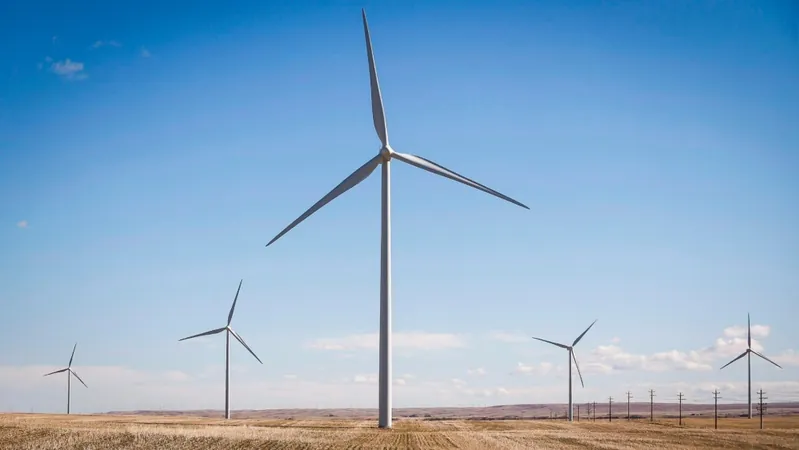
Alberta's Striking New Measures on Wind and Solar Energy: Protection or Restriction?
2024-10-14
Author: William
Introduction
The Alberta government is stepping up efforts to impose new regulations on wind and solar energy facilities, a move that has raised eyebrows among conservationists who argue that these measures may serve to limit renewable energy development rather than protect the environment.
New Regulations and Their Implications
In a controversial bid last year, the provincial government introduced a seven-month halt on new renewable energy projects. Following the moratorium, Premier Danielle Smith emphasized an 'agriculture first' policy for determining the locations of renewable energy initiatives. This approach is not just about green energy, but involves extensive limitations: renewable energy projects are now forbidden within a 35-kilometre radius of 'pristine viewscapes,' parks, and protected areas, alongside a virtual ban in regions with prime agricultural soil.
The Government's Justification
'We must ensure that we do not compromise our agricultural outputs, tourism income, or breathtaking landscapes to hastily push forward renewable energy projects,' Premier Smith stated, defending the new regulations.
Environmental Advocates Respond
However, environmental advocates like Ruiping Luo from the Alberta Wilderness Association view these measures as an overreach, arguing that the government’s actions are aimed more at curbing renewable energy efforts than safeguarding the environment. 'It’s apparent that this is not about genuine environmental protection,' Luo claimed.
Future Restrictions and Their Impact
Looking ahead, Smith indicated plans to extend restrictions not only to viewscapes and cropland but also to native grasses and irrigable land, which could signal an even tighter grip on the renewable energy sector. During community engagement this summer, Alberta indicated a strong possibility of banning wind and solar plants on irrigated lands, with further prohibitions likely for grassland areas as well. Preliminary findings suggest that these burdensome conditions could eliminate as much as 40% of Alberta's land from future renewable energy projects, with nearly 23% rendered off-limits just from the viewscape requirement.
Broader Environmental Concerns
While Luo recognizes the importance of protecting Alberta’s grasslands and parks, she warns that the government’s focus solely on renewable energy fails to address broader environmental concerns. 'Renewable energy isn’t the biggest threat to our grasslands; oil and gas extraction poses a much larger risk,' she pointed out. Luo advocates for comprehensive protections across all forms of development to truly benefit the ecosystem.
Calls for Uniform Regulation
Analyst Jason Wang from the Pembina Institute echoed Luo’s sentiments, underscoring the need for uniform restrictions across the entire energy sector instead of targeting renewables alone. His organization’s recent study revealed that following the moratorium, 53 viable wind and solar projects were abandoned, amounting to a staggering potential generation capacity of 8,600 megawatts — enough energy to fuel every home in the province.
Government's Position Explained
In response, Ashley Stevenson, the press secretary to Alberta's Utilities Minister Nathan Neudorf, stated that these restrictions are fundamentally designed with environmental stewardship in mind. 'These rules support responsible land utilization and prioritize Albertans’ property rights and beautiful landscapes,' she said, asserting that the government is committed to putting residents ahead of industrial energy projects.
Conclusion
While discussions and policy developments continue, the final regulatory framework is expected to be in place by the end of 2024. As Alberta grapples with the balance of preserving its stunning natural landscapes while advancing towards renewable energy adoption, the discourse surrounding energy production promises to intensify.
Stay Tuned
Stay tuned for more updates on this ongoing story! Are these restrictions the right move for Alberta’s future, or a misguided approach that could stifle renewable energy growth?









 Brasil (PT)
Brasil (PT)
 Canada (EN)
Canada (EN)
 Chile (ES)
Chile (ES)
 España (ES)
España (ES)
 France (FR)
France (FR)
 Hong Kong (EN)
Hong Kong (EN)
 Italia (IT)
Italia (IT)
 日本 (JA)
日本 (JA)
 Magyarország (HU)
Magyarország (HU)
 Norge (NO)
Norge (NO)
 Polska (PL)
Polska (PL)
 Schweiz (DE)
Schweiz (DE)
 Singapore (EN)
Singapore (EN)
 Sverige (SV)
Sverige (SV)
 Suomi (FI)
Suomi (FI)
 Türkiye (TR)
Türkiye (TR)